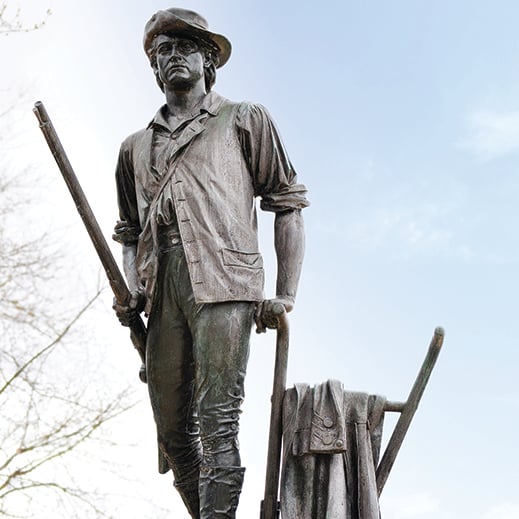Monumental Sculptor
Anyone who has spent spring on campus should be familiar with the Patriots’ Day holiday, Boston’s unofficial beginning of spring and the date of the Boston Marathon since 1897.

Historically, Patriots’ Day honors the first military engagements of the American Revolution—the battles of Lexington and Concord, which took place about 10 miles west of Cambridge in 1775. The battle at Concord’s Old North Bridge is commemorated by The Minute Man, a statue in Concord sculpted by former MIT student Daniel Chester French, who would later become famous for sculpting the colossal marble statue of Abraham Lincoln at the Lincoln Memorial.
French, who lived from 1850 to 1931, spent less than a year at MIT as a student in the late 1860s. According to Chesterwood.org, the website for his historic property in Stockbridge, Massachusetts, he failed physics, algebra, and chemistry before leaving school to work and study with artists John Quincy Adams Ward and William Rimmer.
He was commissioned to execute The Minute Man, his first major monument, in 1873, and the statue was dedicated on the battles’ centenary on April 19, 1875. The seven-foot statue, which depicts a farmer armed with a rifle, launched his career. French spent parts of the next 15 years working in Boston, Washington, D.C., New York, Florence, and Paris.
By the turn of the 20th century, French was a sought-after artist based at Chesterwood, which would be designated a National Historic Landmark in 1965. In 1903, he sculpted Continents, a massive four-work piece at the entrance of the Alexander Hamilton U.S. Custom House in New York City, which depicts four women symbolizing Asia, America, Europe, and Africa.
French produced more than 100 monuments, memorials, and other works during his career, and in 1914, he was selected to sculpt the Lincoln statue. The work took more than three years, and the finished piece, unveiled in 1922, elicited some controversy: some believe that Confederate general Robert E. Lee’s face is carved into Lincoln’s hair.
“What I wanted to convey was the mental and physical strength of the great war President and his confidence in his ability to carry the thing through to a successful finish,” French wrote in 1922.
While his time as a student was unremarkable, French’s Cambridge legacy is permanent. He sculpted the bronze sculpture of John Harvard in Harvard Yard that is a frequent target for MIT hackers, who have added a toilet stall door, a brass rat, and an “Ask Me about My Lobotomy” sign over the years.
Because no photographic evidence exists to indicate what John Harvard actually looked like, an MIT urban legend suggests that French modeled the statue after one of his former MIT classmates.
Perhaps it was a hack, cast in bronze?
Keep Reading
Most Popular
Large language models can do jaw-dropping things. But nobody knows exactly why.
And that's a problem. Figuring it out is one of the biggest scientific puzzles of our time and a crucial step towards controlling more powerful future models.
How scientists traced a mysterious covid case back to six toilets
When wastewater surveillance turns into a hunt for a single infected individual, the ethics get tricky.
The problem with plug-in hybrids? Their drivers.
Plug-in hybrids are often sold as a transition to EVs, but new data from Europe shows we’re still underestimating the emissions they produce.
Stay connected
Get the latest updates from
MIT Technology Review
Discover special offers, top stories, upcoming events, and more.